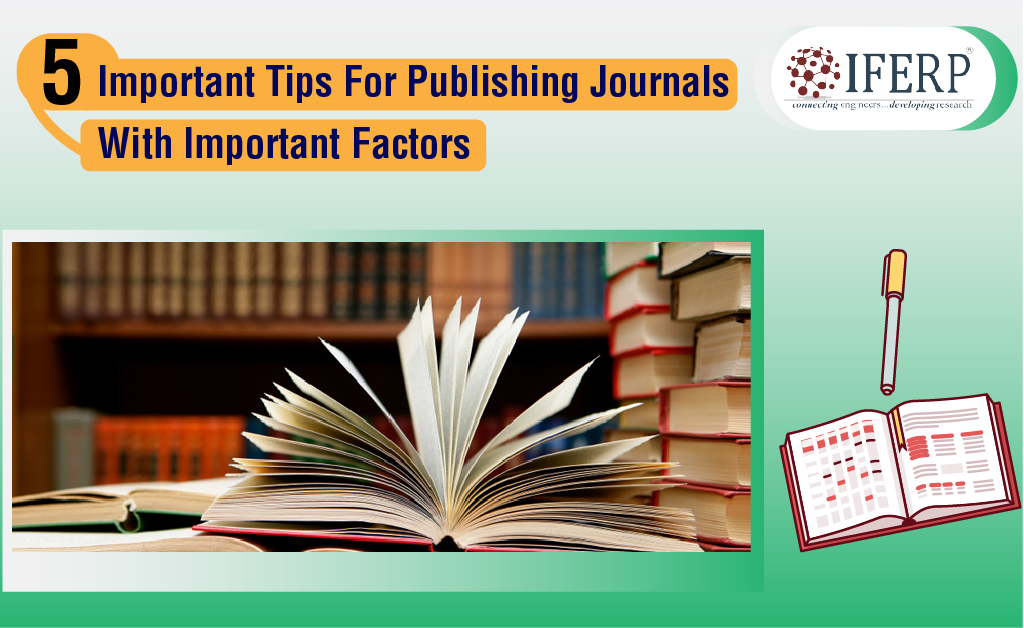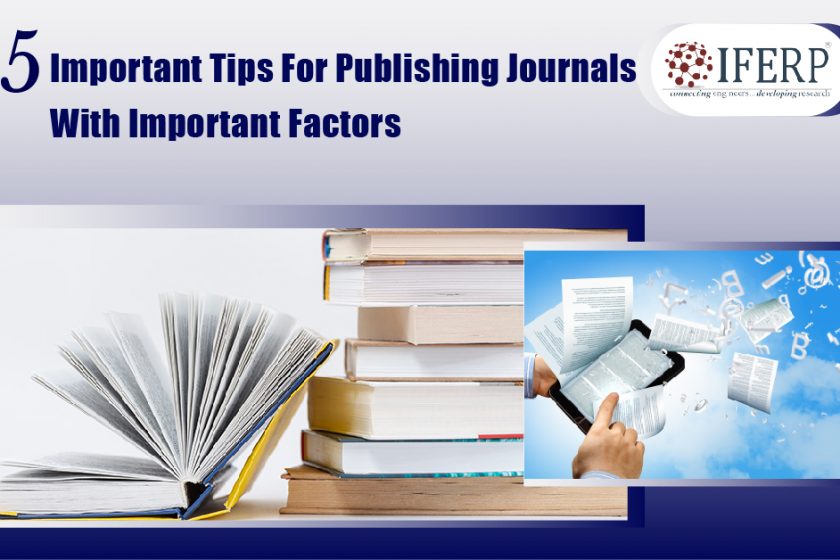The process of materializing an idea or set of findings/data from a research project into a published manuscript can seem quite daunting. This article offers five crucial tips that will help make getting a research paper published in a high-impact journal of one’s choice an absolutely effortless and straightforward undertaking.
- Tip #1
Taking The Time To Identify The Right Journal
Reading a journal’s explicit goals and scope will reveal almost everything one needs to know about what the journal aims to achieve and the type of articles it uses to achieve them. Journals almost always describe their objectives and scope in two places – on their website, usually in their ‘about us’ or ‘instructions for authors’ sections. Many even have ‘submission criteria’ and ‘guide for authors’ sections. These sections include specific parameters for the types of articles that publishers will and will not accept. They will also often indicate the types of research the journal prefers. Reading these sections before looking for additional information about the journal will prove to be immensely helpful. It is useful for authors, as soon as they get a list of journals that they’re interested in to follow the below-detailed strategies.
- Perusing Through Previous Editions Of The Journal
As one does their research (even before they start writing their manuscript), they should read as many journal articles as possible in their field of study. Even if they know the specific requirements of an international journal 2023, reading its articles in depth will help them better understand the types of research and articles that the editors of the journal they’re interested in having their work published in, prefer. By examining the articles from the last few years, one can notice how its editors define criteria terms such as ‘innovative’ and ‘intriguing’ as well as also gain an overall understanding of the style of writing articles typically published in it.

- Keeping An Eye Out For The Impact Factor
Most authors want to submit to respected journals that contain articles referenced by other researchers. They should therefore take the time to research the impact factor (IF) of their target scopus-indexed journal. A journal’s IF metric is evaluated based on how often articles are published in it in the previous two years. Journals with high impact factors contain published articles that are cited by other authors more frequently.
This number gives an approximation of the prestige of a journal in its field. While there are strong arguments for this method of determining quality, the impact factor remains the preferred method for assessing the influence of a journal. It is important to bear in mind that the higher the influence of the journal, the more competitive its submission process is likely to be. One needs to factor in the time and effort it takes to submit to a high-level review and decide if it is worth it for their specific situation. It is a good idea to base this decision on factors such as their previous publishing experience, the scientific merit of their research, and the quality of their submitted manuscript. While most researchers would love to be published in high-profile journals in their field, if they have very little or no publishing experience, it’s almost always a good idea to manage their expectations and submit to somewhat less prestigious journals.
- Tip #2
Ensuring The Research Topics, Findings & Outcomes Are Completely Unique
No scopus journal will be interested in one’s work if it does not present new or new ideas. In order for one’s work to be published, they need to say something new without saying something that challenges their credibility.
Successful academic papers do two things – they position themselves within existing research and then build on existing knowledge. Making clever use of research work and findings that already exist serves as a convenient starting point for researchers to be able to push the limits a little further and discover new things.
New authors often fail to take advantage of this concept. On the one hand, it is not enough to simply reexamine or review the existing research on a certain topic. In order to come up with a great research article or paper, this is just the starting point. The actual effort comes when one makes use of existing literature to pose new questions and then attempts to offer novel resolutions to them.
In order to appeal to an editor of a journal, one’s work must strike the perfect balance between having something unique to offer and not straying too far from the existing knowledge pool. Authors probably won’t get approval if they stretch the meaning of the existing work to fit their new argument, or if their new argument is a huge leap from the existing literature. It is vital to remember that the argument doesn’t have to be groundbreaking to be new or interesting, it just needs to be original enough to make a contribution to what already exists.
- Tip #3
Incessantly Refining & Sprucing Up The Rough Edges
Authors need to have a serious editing and review process if they intend to publish their work. This entails having a process that goes beyond the quick overview they might give an article before passing it on. They should start by doing something very old-fashioned – turning on the printer and grabbing a pen.
When editing their own work, they need to give themselves plenty of time between when they write and when they edit. When writing, a lot of ideas swirling around. All of these ideas make it possible for authors to make logical leaps in their writing that, while these ideas may have meant something at the time, they end up confusing readers.
There are three things authors can look for in their editing process that when addressed will dramatically improve the quality of their articles –
- Remedying Obscure & Perplexing Portions
When it comes to a writing style to adopt, the simpler the better. Nothing will punish an author’s work more definitely than if no one can understand what they are trying to convey. It is crucial to note that brilliant writing is simple writing – a relevant idea delivered sharply and undeviatingly.
- Keeping It Brief & Simple
If an author’s writing is littered with commas, semicolons, and dashes, they should go back and simplify it. While editing an article, authors should be their own worst nightmare. Reading critically and questioning if every single paragraph and sentence makes sense will help them make sure their ideas are connected and cohesive. It is important for authors never to assume that their readers will be able to follow their train of thought, and also bear in mind that the reader is not responsible for understanding what they are trying to convey – they are!
- Writing In The Active Voice
Authors who are new to the passive voice should begin by reading a basic overview. Particularly in unscientific writing, the overuse of the passive voice can lead to writing that is unnecessarily verbose, indirect and lacking in specificity. By thinking twice about their use of passive use, authors are more likely to improve their writing. How? By first, eliminating the passive voice they will simplify their writing, and secondly, by changing passive constructs to active constructs they force themselves to be more specific and offer additional details. While there are some situations where using the passive voice is acceptable, in the vast majority of cases, authors will improve the clarity of their writing by using the active voice.
Overall, their editing process should be a significant part of the work that authors put in until they’re able to reach a conclusive final version of their articles. If they approach this process with a critical eye, they’ll end up cutting out unnecessary passages and elaborating on important details. The result will be a much stronger paper.
- Tip #4
Paying Close Attention To Citations
References are a source of credibility in an academic article. It goes without saying that if authors want their work to be seriously considered by any editor, they have to rely almost exclusively on academic credentials. However, this is only the beginning of their responsibility, and if they pick their citations strategically, authors will significantly increase their chances of being recognized as credible sources themselves.
While choosing citations, authors need to follow some sort of strategy, both to build their argument effectively and to establish their credibility. Avoiding the random method at all costs is recommended, as this is a sure-fire way to show reviewers that they don’t understand the field.
A helpful tip is to cite articles from the Google scholar journal that they’re submitting to. The reviewers who review their work are most likely regular readers of the journal they are reviewing. They may have even written articles in that particular journal themselves or at least provided editorial supervision for articles recently published in the journal. Either way, there’s a good chance they’ll know all of the articles that have been referenced in their journal. This not only helps authors building their own credibility and displaying an understanding of the field, but it’s also a strategic way to tap into the reviewer’s ego, by reminding them that their work and journal is important. Additionally, if they agree to publish, the article will also be counted as another citation for their journal, which is a good thing.
- Tip #5
Taking Self Criticism Seriously & Leaving No Room For External Criticism
Editing an article takes a lot of work. With so many submissions, reviewers are always looking for easy exits or simple criteria to reject an article before they even start reading it. Authors should carefully follow a journal’s guidelines, including their citation formatting requirements.
Assuming all of the guidelines put forth by the journal have been followed and complied with, reviewers will look for clear oversights in the arguments of the article. For example, if authors make statements that are too strong (such as a statement that clearly reveals their personal biases or a statement that dismisses a common controversy), they are making it easy for a reviewer to decline their submission. On the other hand, if they phrase their point in a nuanced way, it will be much more difficult for a reviewer to punch obvious holes in their work.
Ultimately, an author’s success will be determined by how hard they are willing to work and how strong their argument is. Getting published in a high impact Web of science journal doesn’t work of genius – it’s simply the result of a strategic and proactive publishing strategy coupled with a willingness to revise and refine again and again until perfection is achieved or close to being achieved.


